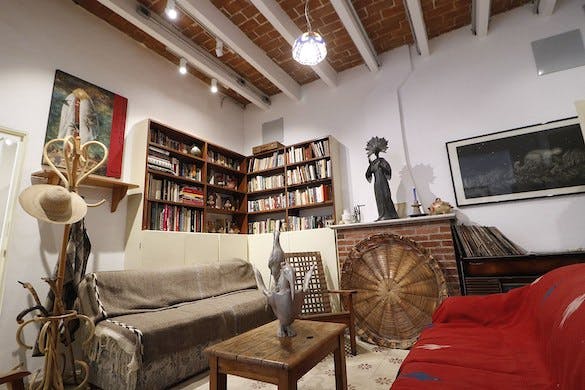Into the Rooms of a Great Artist: You’re Invited
The tone of this biography of Leonora Carrington by her cousin is loving and seems to stem from a desire to share a family member and great artist with the rest of us.

‘Surreal Spaces: The Life and Art of Leonora Carrington’
By Joanna Moorhead
Princeton University Press, 224 pages
A cousin of Leonora Carrington (1917-2011), Joanna Moorhead writes with affection and insight about the British artist, who grew up in a conventional English family that indulged her desire to draw until they realized she had more in mind than becoming a decorative feature of upper middle class life.
This sumptuously illustrated biography provides numerous examples of a painter, writer of fiction, and sculptor who thrived among the surrealists who offered another world and aesthetic that strengthened her rejection of what her family and society thought of as “real.”
Never fitting in at school, Carrington hardly minded and went her own way. Landing in France, she formed an erotic and artistic liaison with a renowned surrealist, Max Ernst (old enough to be her father), though she remained, nonetheless, her own person.
Carrington was beautiful and men wanted to possess her, make her a mistress, but she resisted even when she was low on funds and without a clear sense of how she could support an artist’s life. She never returned to her family in England or communicated much with them, even though many of the places in her art reflect her upbringing.
Besides her time in France, the peripatetic Carrington lived in Italy, Spain, Portugal, and the United States, though Mexico became her home and base of operations, where her cousin/biographer visited her. Carrington married twice, had children, but never sought fame or fortune. She joked with Ms. Moorhead about what it would be like to have one’s art on refrigerator magnets and mugs. Now Carrington’s burgeoning fame has resulted in that commodification of her art.
Ms. Moorhead’s biography takes inspiration from Carrington’s novella, “The Hearing Trumpet,” and its conceit: “Houses are really bodies. We connect ourselves with walls, roofs and objects just as we hang on to our livers, skeletons, flesh and blood streams.”
To get a sense of how wondrous Carrington’s paintings are, heed Ms. Moorhead’s astute description of a “masterpiece” titled “The House Opposite”:
“The painting takes the form of a kind of doll’s-house cutaway, in which different women (all, perhaps, Leonora) are at different stages of life and having different experiences. In the very centre is a girl with a white rocking horse sitting in despair on a forest floor; in a room below, a girl is running into the picture carrying a bird. The energy flows between the rooms, and indeed the figures appear to move freely between floors and through ceilings. As so often, Leonora is exploring boundaries, and this painting showcases that exploration more than most. Where
is the boundary, she seems to be asking, between a human being and a tree? Where does a woman stop and a horse begin? What is the boundary between humans and nature, between men and women, between earth and water (one room seems to be on the seabed)—between life and death? Today we are hyper-aware of the interconnectedness of everything; but Leonora was already depicting that interconnectedness in her work eighty years ago.”
The colors Ms. Moorhead mentions are those of the “16th century greats.” I see a 15th century great artist as well: Fra Angelico, to be specific. In his work, the interiors and exteriors seem to merge — if not exactly in surrealistic scenes, then in supernatural ones that perhaps the surrealists appreciated. It is no accident that Carrington spent a lifetime exploring many different religions and spiritual practices.
Carrington lived into her 90s and never stopped creating art, and never stopped engaging with both the past and present. She took an avid interest in the second wave of feminism, a significant fact because many women of her generation regarded feminism as a kind of special pleading and victimization of their talents that they repudiated.
As we read about Ms. Moorhead’s discovery of her cousin’s life and art, and are privy to their conversations, it is as if we are in one of Carrington’s beautifully crafted rooms. The tone of this biography is loving and seems to stem from a desire to share a family member and great artist with the rest of us.
Some of Mr. Rollyson’s writing on art is collected in “Essays in Biography.”

